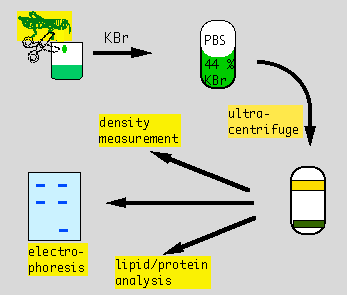

Introduction
Experimental protocol
As insects have an open circulatory system, the hemolymph can be simply collected through an incision in the body wall. Most conveniently, you should cut a leg and let the blood drip into a chilled glass beaker. To get maximum yield, it is necessary to flush out the blood by injecting buffer into the body cavity. The experimental procedure is schematically shown in the following figure.

Following the removal of hemocytes, potassium bromide is added to the hemolymph to form a 44 % solution. This is over layered with phosphate buffered saline (PBS), and centrifuged to form a density gradient. Eventually, all proteins float or sink to the zone that corresponds to their density. Having a lower density, the yellow colored lipoprotein floats higher than non-lipoproteins, including a green cyanoprotein. The separated proteins are fractionated. For the individual fractions, the density is determined by refractometry, protein content and composition by the Bradford assay and electrophoresis, respectively, and the lipid composition can be analyzed by thin layer and gas chromatography.
Note: You need to wear gloves throughout the procedure.
Each groups takes 10-15 locusts.
1. Take 2-5 ml of PBS in a clean 100 ml beaker
and add 25 µl of 200 mM PMSF
Highly poisonous!
2. To bleed hold the locusts by all legs and wings and cut off a leg near thorax (see picture). Make sure no insect saliva drips into the beaker (have Kleenex ready to wipe off saliva).
3. Gently inject a few hundred microlitres
of PBS through segments subcutaneously.
Do not injure the gut!.
4. Flush hemolymph (yellowish due to the presence of carotin) carefully out by squeezing the thorax area gently. Collect blood from 10-12 locusts.
5. Put the bled locusts in a jar. When finished bleeding, movet he jar to the freezer. Dispose off the dead animals at a later date.
6. Make up the hemolymph solution to ~15 ml with PBS.
7. Add 8.9 g of KBr crystals and stir gently using a clean stir bar.
8. Transfer the dissolved portion into a 50 ml measuring cylinder and add more (2-3 ml) PBS to the undissolved KBr and stir until dissolved. Pool these solutions and make up to 20 ml with PBS and stir further in the measuring cylinder.
9. Transfer solution into a 30 ml plastic syringe (held by a clamp) attached to a 18 gauge needle and a capillary tubing (see picture).
10. Let the hemolymph flow into the heat sealable centrifuge tube.
11. Add another 20 ml PBS into the syringe and overlay on the hemolymph.
12. Turn on the heat sealer to warm it up.
13. Balance against the sample from the other group; you must be exact! Use the analytical balance and add or remove PBS to or from the tubes. If liquid is in the neck, remove with the tip of a tissue.
14. Place the metal cap of the tubes, and seal with the heat sealer. As soon as the cap reaches the shoulder of the tube, quicly move the tube to the right and push the cap down with the heat sink.
15. Place the four tubes in the VTi 50 rotor in the opposite positions and place the rotor in the ultracentrifuge.
16. Make sure the lid is closed. Turn on the vacuum of the centrifuge. Set the run conditions to 10 C, brake on, speed 45,000, time 4.5 h.
17. Spin at 45,000 rpm for 4.5 h, and leave sample overnight in the centrifuge..
1. After the run is over, turn the vacuum off and wait until the chamber pressure reaches atmospheric pressure. Now you can remove the tubes.
2. Note any unusual observations during or after the coentrifugation (e.g., leaks), and record in the centrifuge book. Clean the chamber and the rotor, and start a DRY RUN to avoid condensation in the centrifuge.
3. Using a sharp single edged razor carefully
cut open centrifuge tube.

4. Set up the BioRad fraction collector. Fractionate
content into 20 two milliliter fractions.
5. Determine density using the refractometer.
6. Also determine UV absorbance at 280 nm. Remember to use UV-permeable plastic cuvettes (1 pair).
7. While determining the refractive index place 2 pieces of dialysis tubing (each approx. 20 cm long) into a 500 ml beaker filled with dist. water.
8. Leave an aliquot (300 µl) of every other fraction in labeled modified Eppendorf tubes for dialysis.
9. Dialyze against ~1 l of dist. water in the cold room, changing the buffer once.
10. Carefully transfer the yellow lipophorin fractions (normally 3-5 fractions) into dialysis tubing (closed off at the bottom with an orange clamp) using a pasteur pipette.
11. Close the dialysis tube, making sure to leave enough room for expansion during the dialysis.
12. Dialyze against 4 l of dist. water in the
cold room overnight. Change water and repeat dialysis at least
twice.
[BISC 429 home]
[ Enzyme isolation ] [
Lipoprotein isolation ] [ Lipid analysis
] [ DNA isolation ] [
feedback ]